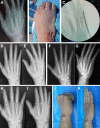Single versus dual elastic nails for closed reduction and antegrade intramedullary nailing of displaced fifth metacarpal neck fractures
- PMID: 33469102
- PMCID: PMC7815815
- DOI: 10.1038/s41598-021-81242-3
Single versus dual elastic nails for closed reduction and antegrade intramedullary nailing of displaced fifth metacarpal neck fractures
Abstract
Closed reduction and internal fixation with antegrade intramedullary nails is a feasible and effective treatment for displaced fifth metacarpal neck fractures (FMNFs). The present study aimed to compare clinical and radiological outcomes in patients with displaced FMNFs after treatment with single or dual antegrade elastic intramedullary nails (AEIMNs). Thirty-three patients were treated with a single 2.0 mm AEIMN and 34 patients were treated with two 1.5 mm AEIMNs. Clinical and radiological outcomes included grip strength, active range of motion (ROM), active flexion and extension of the fifth metacarpophalangeal (MCP) joint, dorsal angulation loss, and metacarpal shortening of the fifth metacarpal at 12 months after treatment. No significant difference was observed between the two groups with respect to grip strength, ROM or flexion of the fifth MCP joint. The average values of dorsal angulation loss, metacarpal shortening, and extension of the fifth MCP joint of the dual nails group were better than those of the single nail group (dorsal angulation loss, 2.79 ± 1.93° vs. 4.05 ± 1.59°, P = 0.009; metacarpal shortening, 1.66 ± 0.80 mm vs. 2.12 ± 0.88 mm, P = 0.028; extension of the fifth MCP joint, 7.71 ± 4.43° vs. 4.82 ± 4.09°, P = 0.012). In conclusion, dual AEIMNs fixation provided better MCP extension and radiological outcomes than single AEIMN fixation.
Conflict of interest statement
The authors declare no competing interests.
Figures




Similar articles
-
Antegrade intramedullary pinning versus retrograde intramedullary pinning for displaced fifth metacarpal neck fractures.Clin Orthop Relat Res. 2015 May;473(5):1747-54. doi: 10.1007/s11999-014-4079-7. Epub 2014 Dec 11. Clin Orthop Relat Res. 2015. PMID: 25502343 Free PMC article. Clinical Trial.
-
Single versus dual Kirschner wires for closed reduction and intramedullary nailing of displaced fractures of the fifth metacarpal neck (1-2 KiWi): a randomized controlled trial.Bone Joint J. 2019 Oct;101-B(10):1263-1271. doi: 10.1302/0301-620X.101B10.BJJ-2019-0410.R1. Bone Joint J. 2019. PMID: 31564142 Clinical Trial.
-
A minimally invasive fixation technique for selected patients with fifth metacarpal neck fracture.Injury. 2016 Jun;47(6):1270-5. doi: 10.1016/j.injury.2016.01.034. Epub 2016 Feb 11. Injury. 2016. PMID: 26971086 Clinical Trial.
-
Antegrade intramedullary nailing for fifth metacarpal neck fractures: a systematic review and meta-analysis.Eur J Orthop Surg Traumatol. 2014 Apr;24(3):273-8. doi: 10.1007/s00590-013-1344-5. Epub 2013 Oct 27. Eur J Orthop Surg Traumatol. 2014. PMID: 24162582
-
Outcomes of Metacarpal Fracture Fixation With Intramedullary Nails: A Systematic Review.Ann Plast Surg. 2025 Jun 1;94(6S Suppl 4):S486-S492. doi: 10.1097/SAP.0000000000004271. Ann Plast Surg. 2025. PMID: 40459447 Review.
Cited by
-
Treatment of fifth metacarpal neck fracture in adolescents with minimally invasive surgery: percutaneous Kirschner wire fixation versus elastic stable intramedullary nailing.J Int Med Res. 2023 May;51(5):3000605231174981. doi: 10.1177/03000605231174981. J Int Med Res. 2023. PMID: 37243605 Free PMC article.
-
Early movement does not cause loss of reduction in surgically treated boxer fractures.Ulus Travma Acil Cerrahi Derg. 2022 Aug;28(8):1142-1147. doi: 10.14744/tjtes.2021.24668. Ulus Travma Acil Cerrahi Derg. 2022. PMID: 35920419 Free PMC article.
-
Postoperative Rehabilitation and Return-to-Sport Criteria Lack Standardization Following Surgical Repair of Metacarpal Fractures: A Systematic Review.Arthrosc Sports Med Rehabil. 2025 Feb 21;7(3):101107. doi: 10.1016/j.asmr.2025.101107. eCollection 2025 Jun. Arthrosc Sports Med Rehabil. 2025. PMID: 40692937 Free PMC article.
-
Comparative Evaluation of the Efficacy of Combined Intramedullary Pinning with K-Wires Pinning in the Treatment of Fifth Metacarpal Neck Fractures versus Conventional Techniques-K-Wires Pinning and Intramedullary Pinning.Medicina (Kaunas). 2023 Nov 3;59(11):1944. doi: 10.3390/medicina59111944. Medicina (Kaunas). 2023. PMID: 38003993 Free PMC article. Clinical Trial.
References
-
- Sun T, et al. Epidemiological investigation of adult metacarpal fractures from 2003 through 2012 in the Third Hospital to Hebei Medical University. Chin. J. Orthop. Trauma. 2017;16:603–606.
Publication types
MeSH terms
LinkOut - more resources
Full Text Sources
Other Literature Sources
Medical
Miscellaneous

